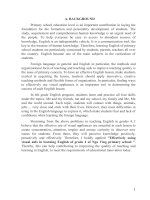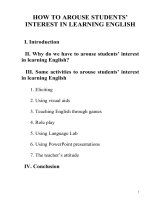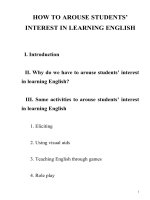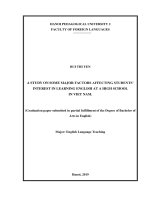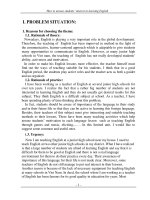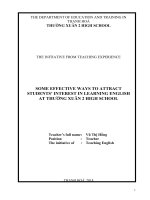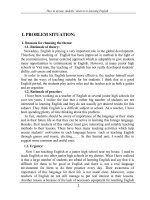skkn tiếng anh 7 how to arouse students’ interest in learning english
Bạn đang xem bản rút gọn của tài liệu. Xem và tải ngay bản đầy đủ của tài liệu tại đây (2.53 MB, 40 trang )
How to arouse students’ interest in learning English
I. Problem situation:
1. Reasons for choosing the theme:
1.1. Rationale of theory:
Nowadays, English is playing a very important role in the global development.
Therefore, the teaching of English has been improved in method in the light of
the communicative, learner-centered approach which is adaptable to give students
many opportunities to communicate in English. However, at many junior high
schools in Viet nam, the teaching of English has not really developed students’
ability, activeness and motivation.
In order to make his English lessons more effective, the teacher himself must
find out the ways of teaching suitable for his students. I think that in a good
English period, the students play active roles and the teacher acts as both a guider
and an organiser.
1.2. Rationale of practice:
I have been working as a teacher of English at several junior high schools for
over ten years. I realize the fact that a rather big number of students are not
interested in learning English and they do not usually get desired results for this
subject. They think English is a difficult subject at school. As a teacher, I have
been spending plenty of time thinking about this problem.
In fact, students should be aware of importance of the language in their study
and in their future life so that they can be active in learning this foreign language.
Besides, their teachers of this subject must give interesting and suitable teaching
methods to their lessons. There have been many teaching activities which help
arouse students’ motivation in each language lesson such as teaching English
through games and music, eliciting,…… In this limited unit, I would like to
suggest some common and useful ones.
1.3. Urgency:
Now I am teaching English at a junior high school near my house. I used to
teach English at two other junior high schools in my district. What I have realized
is that a large number of students are afraid of learning English and say that it is
difficult for them to be good at English and there is not a real language
environment for them to do their practice every day. Their awareness of
importance of this language for their life is not made clear. Moreover, some
teachers of English do not still manage to put real interest in their lessons.
Another reason is because of the lack of necessary equipment for teaching English
at many schools in Viet Nam. In deed, the school where I am working as a teacher
of English has been famous for its good quality in education for years. Most
-1-
students of my school are well brought up by their parents and they identify a
to studying,
arouse students’
interest
Englishresults for English
good motivation inHow
their
which
leadsintolearning
better study
as well as other subjects at school.
1.4. My ability:
Necessarily, among the teachers of my school I should work harder and harder
so as to master the language and always give my students good lessons, which
means that my students’interest in learning English is aroused. That is the matter I
have been absorbed in and that is the reason for my theme.
2. Purpose of study:
I would like to give out some of my own experience in arousing students’
interest in learning English.
3. Researched knowledge:
Ways to make students more excited about their English language lessons so that
they should get better knowledge of English from their English lessons. It means
that their level of the language should be developed.
4. Researched participants:
Students of my junior high school.
5. Ways to conduct the theme:
- My real teaching in classes
- Surveys
6. Time and place for conducting the theme:
- Time: School year 2013- 2014; School year 2014- 2015
- Place: At my junior high school
-2-
How to arouse students’ interest in learning English
II. PROBLEM SOLUTION:
1. Logical basis:
In deed, English has been a newer subject than the other subjects taught in
junior high schools in Viet Nam. Teachers of English in Viet Nam should manage
to learn a large amount of teaching experience from foreign teachers of the
language. The most important points are the number of teaching techniques which
help develop students’ motivation in learning the language and ways teachers use
to apply these teaching techniques in their classes.
2. Practical basis:
Many methodological materials present a great number of interesting classroom
activities. However, some teachers may not have the good chance to be familiar
with most of these activities or some may be afraid of spending a lot of time
thinking about their best activities for their lessons or some may know those
teaching activities half-way. Consequently, many Vietnamese pupils has very
little interest in learning English.
3. Some activities to arouse students’ interest in learning English:
There are various activities in a classroom to arouse students’interest in
learning English. The following may be extremely helpful:
3.1. Eliciting:
In many classes, it is the teacher that talks while the students listen. If the
students take speaking tasks, it is usually to repeat what the teacher says, or to
answer a set of questions. This way of teaching will obviously make the students
feel bored and frustrated. Instead of simply giving words, sentences, or structures
directly, the teacher should involve the students more by eliciting them from the
students. He should ask them for their ideas and suggestions, get them to
contribute what they already know, and encourage them to guess new words. This
is called eliciting.
Eliciting involves the class by focusing students’ attention and making them do
some thinking activities. This happens even if students do not know the words
which are being elicited, so elicitation can be used for presenting a new language
item as well as reviewing what was taught earlier. Furthermore, eliciting
encourages students to draw on what they already know or partly know or do not
know. So it is a useful technique for mixed ability classes or classes of students
from different learning backgrounds, from which different students know
different things. In addition, eliciting gives teachers a chance to see what students
know and what they do not know, so teachers can adapt the presentation to the
level of the class. Of course, an eliciting presentation takes more time than a
straightforward presentation of a new thing. However, eliciting will catch
students’ attention and they will remember the new knowledge better.
-3-
Some ways of eliciting:
3.1.1. Eliciting
from
pictures:
How
to arouse
students’ interest in learning English
- Using pictures to elicit is the easiest way to introduce a new topic or new
vocabulary. When students are elicited from pictures, they should be asked fairly
general questions that allow a variety of responses. This encourages more students
to respond and leads them to say more. For example, to elicit from the pictures in
unit 12 of the textbook “TIẾNG ANH 7”, section A1 (on pages 114 and 115), I
can ask my students to look at the picture and answer the question: “Where are the
people?” and then I say: “ You can answer the question in Vietnamese.” and my
students can answer my question in Vietnamese like this: “Họ đang ở tại quầy bán
hoa quả”. Then I give out the answer in English, “ They are at a fruit stall.”. As a
result, I have succeeded in presenting the word “ fruit stall” to my students.
Where are the people?
They are at a fruit stall.
This picture is shown as the illustration
Then I can ask my pupils to look at the following picture and ask them to
answer my question,“where are they?” and without any of my further explanation,
-4-
my pupils can answer the question in English, “They are at a meat stall.” The
result is that the word “meat stall” is presented in an interesting and easy way.
How to arouse students’ interest in learning English
The following picture can be the example of illustration extracted from my
powerpoint lesson plan – (“TIẾNG ANH 7”/ Unit 12-A1)
Where are they?
They are at a meat stall.
And the same elicitation is used to introduce the word “vegetable stall”
-5-
Where are they?
How to arouse students’ interest in learning English
They are at a vegetable stall.
The pictures below can be the examples of illustration extracted from my
powerpoint lesson plan – (“TIẾNG ANH 7”/ Unit 12-A1) when the words such as
“cucumber”, “spinach”…….. are presented.
What are they?
(in Vietnamese)
cucumbers
-6-
What kind of vegetable is it?
Vietnamese)
How to arouse(in
students’
interest in learning English
What kind of fruit can you see?
(in Vietnamese)
papayas
-7-
Howkind
to arouse
students’
interest
in learning
English
What
of fruit
does
the
picture
show you?
(in Vietnamese)
a pineapple
What is this?
(in Vietnamese)
a durian
-8-
In what state are these fruits?
(in Vietnamese)
How to arouse students’ interest in learning English
They are ripe
Of course, different questions (as above- illustrated) are designed in order to
make my presentation of the new vocabulary more interesting.
- In fact, sometimes students may not answer one or two of teachers’ eliciting
questions because they may have very little knowledge about that field . In this
case, teachers should give out this presentation . The advantage of trying to do
some eliciting first is that students’ attention will now be focused on the
word/words and they should be learning it/them with their greater interest.
3.1.2. Getting students to guess:
- Because the language follows rules, it is often possible to guess things which
students have never actually been taught, and an important part of learning a
language is developing this ability to make guesses. Eliciting is one way of
encouraging students to make guesses and to work out rules for themselves.
Learning through this way will fill students with enthusiasm.
- For instance, to elicit the topic of Unit 12 of the textbook “TIẾNG ANH 7”, I
let my students play Kim’s game with some nouns showing food and encourages
them to guess the topic of the unit by circling the three choices. The following
slide from my powerpoint lesson plan is shown as the illustration.
-9-
After the
please
what is the
Howgame,
to arouse students’
interestguess
in learning English
topic of UNIT 12
a. Let’s drink
b. Let’s play
c. Let’s eat
- Another example is extracted from my powerpoint lesson plan for Unit 5
(B3) of the textbook “TIẾNG ANH 7”. Before letting my students read the text
(B3) in silence in order to answer the question “ What do American students
usually do at recess?”, they try to guess the answers by completing a network.
Read
Prediction
Play basketball
Recess activities in
American Schools
- When getting students to guess, the teacher should pay attention to these points:
+ The teacher should pause after asking each question so as to give students
time to think.
- 10 -
+ The teacher should vary his or her questioning techniques according to the
difficulty of the questions, letting good students answer difficult questions and
directing easier questions
at weaker
Ininthis
way,English
the whole class will be
How to arouse
students’ones.
interest
learning
involved.
+ The teacher should try to elicit “onto the blackboard’, building up a set of
examples as students respond.
3.1.3. Getting students to imagine:
- A textbook often includes only questions that will elicit key vocabulary or
structures, or to establish a situation or a topic. Therefore, the teacher should take
every opportunity to ask questions that require students to interpret what is in a
picture or a text (EX: To get students to interpret the picture in Unit 10 (B1) of the
textbook “TIẾNG ANH 7”, I can ask my pupils to look at the picture and imagine
“What is happening to Minh?”), or to imagine things beyond a picture or a text
(EX: What will Minh do ?/ How will he feel when he sees the dentist?/……..).
- There may be no single “right” answers to these questions but a wide range of
possible answers. Students are encouraged to express their own ideas and feelings.
Questions of this kind encourage students to give a more imaginative, personal
response. If we ask questions like that, we can involve the class in discussion and
can stimulate freer use of language.
3.2. Using visual aids:
- There are various kinds of visual aids that teachers can use to teach English
- 11 -
such as the blackboard, real objects, flashcards, charts, teachers themselves, etc.
- Using visual aids has a lot of benefits:
+ Showing visuals
focuses
attention
oninmeaning,
and helps to make the
How to arouse
students’
interest
learning English
language used in the class real and alive.
+ Having something to look at keeps students’ attention, and makes the
lesson more interesting.
+ Visuals can be used at any stage of a lesson. Visual aids are used to
present a new language, to introduce a topic, as a part of language practice, and to
review the language that has been presented earlier. Good visual aids are not just
used once, but again and again, and can be shared by different teachers.
In this part, I would like to study some familiar visual aids used in a classroom.
* The blackboard: The teacher or students can use it to note the important
points of the language, to draw pictures, diagrams, maps, etc. Simple pictures
drawn on the blackboard can help to increase the interest of a lesson, and are often
a good way of showing meaning and conveying situations to the class. Blackboard
drawings should be as simple as possible, showing only the most important
details. It is not necessary for teachers to be good artists to create their drawings
successfully on the blackboard. A lot of information can be conveyed by means of
very simple line drawings and “stick figures”, which are easy and not timeconsuming for teachers to draw. It is important for these drawings to be drawn as
quickly as possible so as not to lose the interest of the class. Teachers should also
talk while drawing. In this way, the class will be more involved and will
understand the picture on the board both from seeing it and from listening to the
teacher. The following photos were taken from one of my lessons - (Unit 6/B2TIẾNG ANH 7) at my classes (school year: 2014- 2015). The fact is that the
whole class involed the lesson with interest.
- 12 -
How to arouse students’ interest in learning English
This game was used to warm up the lesson at the beginning of the lesson
The technique was used for the “Post- reading” activity of the lesson
The photo below was taken from my lesson taught at my classes Unit 7
(A2,3) – “TIẾNG ANH 7”
- 13 -
How to arouse students’ interest in learning English
The technique was used here as an exercise for the “While- reading”
* Real objects: (sometimes called “realia”):
They can be the things that are already in the classroom such as fans, desks,
tables, walls, clothes, etc. Teachers can also bring real things into the classroom
like foods, clothes, household objects, containers, etc. Real objects are in many
ways the easiest kind of visual aids to be used in class as teachers need no special
preparation. Simple objects can be used not only for teaching vocabulary but also
as prompts to practice structures and develop situations. Realia can be used in
many lessons in TIẾNG ANH 6, 7
Example: The teacher can show a ruler.
** to teach the word “ruler”
- 14 -
** to practice the structure “What is this/that/it?”- It is a ruler.
* Charts:
They are large How
sheets
of cardstudents’
or paper
withinwriting,
to arouse
interest
learning pictures
English or diagrams, used
for more extended presentation or practice. They can usually be displayed on the
wall or on the blackboard, or the teacher can hold them up for the class to see.
Using charts is convenient because of the following reasons:
** The teacher does not have to spend time in the lesson drawing or
writing on the blackboard
** As the chart is prepared in advance, it is possible for teachers to
draw pictures or tables more carefully and also to make them more attractive (e.g.
by colouring them)
** The chart can be kept and used again with the same class (e.g. for
review), or used with other classes and by other teachers.
The textbooks we are using now are up-to-date and have good illustrations.
There may be no need for teachers to make charts. However, it may still be
worthwhile to copy some visual materials from the textbooks onto charts, so that
the teacher can introduce the lesson in a more interesting way, or review earlier
lessons, or simply make a change of activity.
* Flashcards:
They are cards with single pictures which can be held up by the teacher. They
can be used for presenting and practising new words and structures and for
revision. Teachers can draw a picture on the flashcard, or stick on a picture from a
magazine; flashcards can also be used to show words or numbers. Good
flashcards can be made by paying attention to these points:
** They should be large enough – at least 20 x 14 cm (half a piece of
typing paper).
** Pictures can be drawn with a thick pen so that they are clear, or they
can be cut from a magazine. Pictures from magazines are often more interesting
for students to look at, but it is difficult to find pictures which are in the right size
and which are simple enough.
** If possible, flashcards should be made on pieces of white card. Then
they can be kept and used again.
* The teacher herself:
The teacher can use gestures, facial expressions, and actions to help show the
meaning of words and to illustrate situations. The teacher can smile before the
class to teach the word “smile”- (TIẾNG ANH 7). The teacher can mime someone
sneezing to teach the word “sneeze”- (TIẾNG ANH 7). Most action verbs (sit,
stand, write, etc) - (TIẾNG ANH 6) and some adjectives (happy, worried, etc)(TIẾNG ANH 7) could be taught in this way.
3.3. Teaching English through games:
- Students are greatly keen on participating in games. So teaching English
through games is the most effective way to make students interested in learning
English. From my personal experience and from some reference books, I would
- 15 -
like to introduce some common games.
3.3.1. Guessing game:
There are different
tostudents’
organizeinterest
different
guessing
games:
How toways
arouse
in learning
English
For example:
+ The student who is chosen writes a word or a sentence on a piece of paper.
+ The teacher has this student go to the front of the class. Other students ask
him/her yes-no questions to guess the word or the sentence.
+ The student who can guess the word or the sentence will replace this student
and continue the game.
+ The teacher can also divide students in groups. Each group will think of a
word or a sentence and the representative of each group will go to the front of the
class in turn. The group who can guess the word or the sentence will get three
marks. The group with more marks will be the winner.
Or
+The teacher searches old magazines and finds photos of simple things such
as dogs, cats, cereal boxes, baseballs, pencils, school bags, and so on, to use them
as objects
+The teacher cuts out the selected photos and pastes them on 3x5 index cards.
+The teacher places the cards in a large box and jumbles them up.
+ Students take turns to pick up a card from the box.
+The student will have to use words that describe the object on the card. He/
She has to make sure that he/she does not speak out the name of the object.
+The others seated have to guess the name of the object.
+The one who guesses it right takes the next turn.
3.3.2. Lucky numbers:
This game is usually designed as a way to check students’ answers to a series
of reading comprehension questions so that students will feel more excited about
their lesson. The game is played as follows:
+ Have students form groups (It is up to the number of the students in class).
+ Write some numbers on the board.
E.g: 1 2
3
4
5
6
7
8
9
10
+ There are some lucky numbers (e.g. 2, 5, 9). The group who choose the
lucky number will get 2 marks without doing anything.
+ The other numbers each will show a question or an order. If the group can
answer the question or perform the order well, that group will get 2 marks. If that
group cannot answer the question or cannot perform the order, the other groups
will have the right to do that.
+ When all the numbers have been chosen, the group with more marks will be
the winner.
Lucky stars and Lucky animals are very similar to Lucky numbers. The only
difference is that the numbers (1,2,3,……….) are replaced by the stars or animals
that are numbered 1,2,3,…………..
3.3.3. Jumbled words:
- 16 -
This example (including the answer keys in red) is taken from my lesson
(Unit 6: Places/ A1- « TIẾNG ANH 6 »). I hold the game to check my students’
How to arouse students’ interest in learning English
homework.
JUMBLED WORDS
hotel
lake
aelk
ohtel
dray
yard
vrier
retes
wfleros
trees
flowers
river
3.3.4. Word square:
+ The teacher shows a word square on the board and form 2 or 4 groups of
students. The teacher gives the topic related to the words and the number of words
that need to find. The representative of each group will go to the board and circle
the words. The group with more correct words will be the winner.
E.g: A Word square with its answer keys
- 17 -
Word square
How to arouse students’ interest in learning English
Circle the 8 correct words
about the weather and seasons
s
p
r
i
n
g
f
u
e
n
w
j
a
c
m
n
c
o
l
d
o
m
g
p
l
m
m
o
e
h
t
p
r
x
l
r
o
z
w
a
r
m
h
r
e
t
n
i
w
Warm-up stage of Unit 13 (A3) – Tiếng Anh 6
3.3.5.Word forks:
+ The teacher writes the word forks on the board
E.g:
a bed
a cake
a decision
an error
make
a mess
…
…
…
+ The teacher has students work individually or in groups to find the
information to fill in the word forks.
+The first student or the first group that can complete the task correctly will
be the winner.
3.3.6. Network:
+ The teacher writes the network on the board.
- 18 -
+ Students work individually or in groups to find the information to fill in the
network.
+ The first student
orarouse
the first
groupinterest
that can
complete
the task correctly will
How to
students’
in learning
English
be the winner.
The technique was used for the “Post- reading” activity of the lesson
3.3.7. What and where:
The game is often played after the vocabulary is presented. This teaching
technique helps students remember the new words better in an exciting way. The
teacher conducts the game in the following steps:
+ Draw circles on the board, corresponding to the number of the words that
have just been taught.
+ Write the words onto the circles.
+ Have students read the words.
+ Rub out the words in turn and have students read aloud the word that has just
been rubbed out
+ Have students write the words again onto the correct circles.
3.3.8. Kim’s game:
This game is designed to help develop students’ ability of memory. The
teacher can follow these steps:
+ Divide the class into groups.
+ Show students some objects or pictures
+ Hide the objects or pictures.
+ Call on the representative(s) of each group to go to the board to write the
names of the objects or pictures. The groups with more correct names will be the
winner. The following is an illustration extracted from my powerpoint lesson
- (Unit 12/A1- TIẾNG ANH 7)
- 19 -
KIM’S GAME
How to arouse students’ interest in learning English
This is the answer key of the above game
Pork
Beef
Cabbages
Tomatoes
Chicken
Carrots
Mangoes
Bananas
Beans
Oranges
Apples
Peas
3.3.9. Slap the board:
The teacher can organize the game after presenting the new words so as to
help students remember the new words better in a ralaxing way.
+ The teacher writes the new words or sticks the prepared pictures onto the
board.
+ He calls on two groups to go to the board (Each group has four or five
students).
+ Each group stands in the same distance.
- 20 -
+The teacher says aloud the words in Vietnamese if the words on the board are
in English and vice versa. He says the words in English if using the pictures).
+ The studentsHow
of the
two groups
go to
the board
and slap the word said
to arouse
students’will
interest
in learning
English
aloud.
+The teacher gives marks to the group that can slap the words correctly and
more quickly.
+ The groups with more marks will be the winner.
3.3.10. Find someone who:
+ The teacher writes the table on the board and has students write it on their
notebooks
Sports activities
Roller- skate
Skip rope
Play soccer
Play basketball
Swim
Play baseball
Roller- blade
Play tennis
Names
Nam
The game has been used as the lead-in part of one lesson of Unit 13- TIẾNG ANH 7
+ He has students make yes-no questions for the words in the left column
(e.g. Can you roller-skate?/ Can you skip rope?)
+ He gives the model with a student by asking the student a question (e.g. Can
you roller-skate, Nam?). If the student answer “Yes”, write his name on the
column “Names”.
+ Students go around the class and ask other students to find the names to fill
in the table. The names must be different. The student who can fill all the blanks
first is the winner.
3.3.11. Simon says:
The teacher designs the game as follows:
+ The teacher says aloud orders. Students just perform the teacher’s orders if
the teacher begins with, “Simon says”
+ If the teacher says, “Simon says: stand up”, the students will stand up
+ If the teacher says, “stand up”, the students will not stand up
+ The students who make mistakes will be punished in some funny ways.
3.3.12. Pelmanism:
+The teacher prepares some cards and writes the content that need to be
practised on one side of each card (e.g. the content is to practise the verbs of the
base form and the past tense form).
+ He writes 10 verbs of the base form on ten cards and sticks them on the left
of the board.Then he writes the past tense form of the verbs on other ten cards and
stick them on the right of the board. The side of each card which is blank must be
- 21 -
shown.
+ He divides the class into 2 groups and gets each group to choose 2 cards in
turn.
How to arouse students’ interest in learning English
+ Each group turns up the chosen cards if they belong to the same verb (e.g.
eat – ate), that group will get marks. If not, the group turns down the cards and
sticks them on the original positions. The game continues until all the cards are
turned up.
+ The groups with more marks will be the winner.
3.3.13. Noughts and crosses:
+ A table of nine squares is drawn. Each square contains a word or a picture.
EX:
Supermarket
Souvenir shop
School
Post office
Bookstore
Village
Hotel
Street
School
+The class is divided into 2 groups: one is “Noughts” (O) and the other is
“Crosses” (X)
+The groups choose the words in the squares and make sentences with the
words (e.g. There is a post office near my house.)
+ The group with a correct sentence will receive an “O” or an “ X”
+ The group with “O O O” or “X X X” in the same vertical line, diagonal line
or horizontal line first will be the winner.
3.3.14. Crossword puzzles:
This is the illustrative example of Unit 7(A1,2)- TIẾNG ANH 6
- 22 -
Crossword puzzle
How to arouse students’ interest in learning English
1
2
3
4
5
6
7
8
9
d o
m
b o
m o
t r e
Yy
o
u
r
h
o
u
s
e
a
r
s
i
o
k
n
t
r d
e
v
t
s
t
a
u
e
e
t
a
d
m
r
l
o r e
i n
i u m
Key word
3.3.15. “Composing Stories”:
This game can be played by the whole class or in groups. The purpose of this
game is to cultivate students’ reading comprehension and memory. For example,
the teacher delivers ten disordered sentences of a paragraph from a text which
students have learned. The winner will be the group who can rearrange them
correctly and the fastest.
3.3.16. Miming:
+ The class is divided into groups.
+ The representatives of the groups will go to the front of the class to mime a
job or an action in turn.
+ Each correct answer will be given 1 mark. The group that has the student
who mimes and can give the correct answer will be given 2 marks. The group
- 23 -
with more marks will be the winner.
3.3.17. The teacher can also design games which are similar to popular games
on television suchHow
asto“Chung
sức”, interest
“Rung inchuông
arouse students’
learning vàng”,
English “Đường lên đỉnh
Olympia”, etc. (Instead of using Vietnamese in these games, we will use English)
The following example is the game which is similar to the game “Chung sức”:
+ The teacher divides the class into 2 groups.
+ He says: “I had a survey on 100 students and got 10 answers to this question.
If you give one of those answers, you will receive the marks which are equivalent
to the numbers of the students giving that answer.”
+The teacher writes on the board:
1. ____________ (20 students)
2. ____________ (17 students)
3. _____________(15 students)
4. ____________ (12 students)
5. _____________(11 students)
6. _____________(9 students)
7. _____________(7 students)
8. _____________(5 students)
9. _____________(3 students)
10. ____________(1 student)
+The representatives of the groups go to the front to slap the board to get the
right to answer.
+ The teacher asks the question: “What do you often do in your free time?”
+ The student who slaps the board first will get the right to answer first. Then
each group will give one answer in turn.
Answers:
1. watching television (20 marks)
2. listening to music(17 marks)
3. chatting on the phone(15 marks)
4. playing computer games(12 marks)
5. going shopping(11 marks)
6. reading books(9 marks)
7. playing sports(7 marks)
8. meeting friends(5 marks)
9. traveling(3 marks)
10. sleeping(1 mark)
+ After all of the ten answers are given, the group with more marks will be the
winner.
3.4. Role play:
Role play is a way of bringing situations from the real life into the classroom.
When teachers organize this classroom activities, they ask students to imagine.
They may imagine:
- a role: in other words, they pretend to be a different person (e.g. a dentist)
- a situation: in other words, they pretend to be doing something different (e.g.
- 24 -
making a plate of stir-fried beef)
- both a role and a situation (e.g. a dentist asking about a school boy’s toothache).
In role play, students
improvise.
Theinterest
situation
is fixed,
but they make up the
How to arouse
students’
in learning
English
exact words to say as they go along. ( So reading a dialogue aloud is not the same
as role play.)
Role play increases motivation. Always talking about the real life can become
dull, and the chance to imagine different situations adds interest to the lesson.
Children and even teenagers and adults often imgine themselves in different
situations and roles when they play games, so by using role play in class, teachers
are building on something that students naturally enjoy.
When using role play, teachers bear in mind that the situations used for role
play should be as far as possible within the experience of their students. In
general, the more familiar a role or a situation is, the easier it will be.
Suitable roles for school classes would be:
* People familiar to students from everyday life such as parents, brothers,
sisters, teachers, shopkeepers, police officers.
* Characters from the textbook, and from other books or from television.
Suitable situations:
* Situations which students see or take part in in everyday life like
shopping, going on holidays, using local transports, asking the way to places.
* “Fantasy” situations from stories they read, or from the textbook.
3.5. Using Language Lab:
To inspire students with great interest, teachers can teach them in a language
lab. In fact, there are many benefits of using the lab to teach English, especially in
teaching speaking and listening. In a language lab, the teacher can easily show a
picture, a film, or play a song without taking a lot of time. Besides, the noise from
films, songs or students’ activities will not cause any trouble for any surrounding
classes. In addition, students can enjoy eye-catching pictures with wonderful
soundtracks which make them feel much eager and give them more interest in
learning the new lesson. For instance, to lead in unit 12/ A1 “TIẾNG ANH 7”, I
showed my students a video clip of an English song called “I like the food” and to
lead in Unit 13/A3“TIẾNG ANH 6”, I showed my students a video clip of an
English song called “My favourite seasons”. After seeing the video clips together
with my trasitional words or exercises, my students felt much more interested in
getting ready for the new lesson.
3.6. Using PowerPoint presentations
PowerPoint presentation can make the class teaching much more interesting. It
can help catch students' attention with the help of some vivid and proper pictures
or sounds. The interesting sounds and flashes can cheer students up in class. Thus
students may be more impressed and remember the vocabulary or the sentence
patterns easily and can keep the memory longer.
PowerPoint presentation is a great way of displaying pictures and linking to
movie clips. It does break the monotony in the classroom and adds a variety.
- 25 -

